How Managing Your Brand’s Reputation Will Help Your Local Strategy

Managing your brand’s reputation will help your local strategy in several ways. In this article, I will zoom in on what we mean with digital reputation and how you can use ratings and reviews to improve it so you can actually use it as a separate marketing channel.
Key takeaways:
- How to manage your online brand reputation
- How to Reply to Online Local Reviews
- Guide for asking for Reviews
The Local Industry
The local industry is on a rapid growth, tracking to be a $100B industry in coming years. These days people are more frequently using local search methods to find businesses of any industry. BiA/Kelsey, for example, claims that up to 97% of people use local searches to research about online products or services.
To successfully capture traffic from these searches, businesses will need to spend more of their budget on local marketing techniques to extend their organic reach, thereby lowering PPC budgets. In addition to this, brands will need to assess their online reputation scorecard, such as their ratings and reviews in order to capture attention in the ‘zero moments of truth’.
What is Online Reputation Management
Online brand reputation is often confused with brand monitoring, social media monitoring, or even PR.
What it basically means is that you manage the presentation of your brand on every channel your customer searches for you. Managing your reputation is all about managing perceptions. You want people to perceive your brand as good, trustworthy, etc., and you want people to talk positively about your goods and services.
In the current digital age, people talk about your brand whether you like it or not–it’s happening out of your control. So for businesses, it has become imperative to monitor, listen carefully, and favorably reply to these conversations to avoid any unwanted repercussions.
Example Case
Say I’m in an unfamiliar city and am looking for a place to stay. I search Google Maps using ‘Hotel near me’. Google shows me 10 of the nearest hotels. Now I have the option to scan each listing by name or see whether I recognize the brand name. Otherwise, I can filter the listings based on three things: ratings and reviews, price, and proximity.

But honestly, who wants to stay in a cheap hotel that received poor ratings no matter the distance?
I would never go to a hotel just because it’s nearby although people have said I should not go there.
Personal recommendation from peers here is very influential. In fact, 88% of people trust reviews by peers more than any other source.
When most aspects of the reviews and ratings are to my liking, I would probably search for the one with the best ratings and try to match a desirable price and proximity.
As this example shows, the brand’s reputation was a huge marketing pull factor in my search for a hotel.
For big brands like Starbucks or McDonalds that acquire a lot of reviews, it’s really unwanted if many of them are negative and unanswered. Sometimes, people can say awful things that have the ability to direct people to competitors. For example:
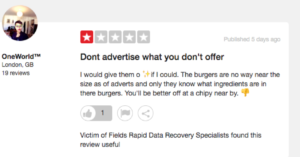
“This is sort of the Dorian Gray’s portrait of all McDonalds; all that processed, chemically, quasi-food that makes up their offerings is physically manifest in one single location. In other words: for once, a McDonalds truly looks how it tastes. Avoid.”
David D. Source.
Effects
What will do with your brand perception of this specific McDonalds location? You would probably either search another location nearby or walk to the competitor’s front door.
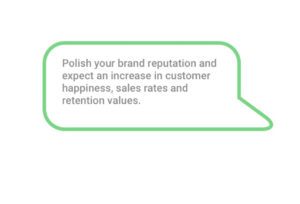
Online brand reputation management is an important component which you can use to your commercial advantage. If not properly managed, it can cause actual business distress and loss of money.
Online reviews are like a double-edged sword: they can really help improve your business rating or otherwise have the ability to destroy it. Managing them properly, therefore, is imperative for marketers need to understand. Vendasta’s Media Company Survival Guide asked media agencies what they needed to learn more about and where the gaps are. Local SEO came in second and reputation management scored a third place. Its importance is undeniable.
Five steps that will help you using brand reputation management as a marketing channel.
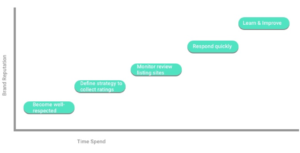
-
Become a well-respected brand.
First things first: you need to be a well-respected brand in order to receive positive reviews. This sounds like an open door, but in reality, is often not thought of as a first basic step. Businesses need to understand that their customers are not mouth dead anymore. They can talk to each other and everything you do to make them smile or cry can affect your prospects.
Example: Coolblue is Holland’s largest best-rated e-commerce website. It has been chosen year in and year out as the best brand in terms of brand image and customer service. Their positive ratings and reviews are going through the roof. Why? Because their in-house service team triples any other department in their company and the way they treat their customers is unparalleled. They invest full-on in customer experience and have dedicated social media teams to handle complaints or answer reviews. The brand is extremely well-respected and you can see that in their ratings: 4.4 out of 5 on Google. That’s some business card they have there!

In order to make your brand stand out from the rest on Google, Yelp or any other review listing site, be sure to make customers smile about you.
-
Establish a process to collect positive online reviews from your current and former customers.
Perhaps no one understands the value of feedback more than Google, who actively promote ratings and reviews through local guides and in-app pop-ups. They also regularly blog about the success rate of asking for reviews. They are on a mission to ramp up the number of ratings and reviews – but it definitely shows that they become more and more important and that asking for them is not hurting a businesses reputation.
So, you need to start developing a process to collect positive reviews from your current and former clients. This is needed in order for your business to flourish.
There are a couple of ways you can achieve this:
Ask people in person
Personal contact beats digital anytime. If you have solid relationships with your customers and you know they are very likely to rate you, then just ask for it. There is a good chance they will help you out. Perhaps even more so if you tell them that Google rewards its reviewers with free storage space.
Ask them through email
If you have a list of clients or former clients you have lost contact with, an email might be the better and faster option. Though, be careful; you are asking for a personal favour and emails feel more commercial than personal conversations. Stay away from HTML formats, be careful with using your business name in the subject line and try to make the email as personal as possible. Many companies make the mistake by pushing out dozens of impersonal emails that look almost like they want to upsell you. Be as personal and non-commercial as you can be and don’t forgot to thank them warmly when they answer you.
Offer an incentive
In some cases, offering some sort of incentive might be an option but certainly isn’t the case of all businesses. Incentives, like free coupons, could motivate people to write a review and possibly open the door for a retention program. Yotpo has sent 3500 emails asking for reviews to the test to see what worked and what didn’t. It’s great knowledge to hover over sometimes to see how you can optimize your email strategy.
They concluded the following:
The data shows that including words that signify a financial incentive to leaving a review (like a coupon, win, free, save, sale, discount, etc.) work, increasing the conversion rate from shoppers to reviewers by 18.5% on average.
Train personnel
Training personnel is another great way of quickly gaining reviews. If personnel are trained to leave smiles on the faces of customers and take them by their hand during the whole customer journey, gold will await at the end of the rainbow.
Remember: Highly satisfied customers are not as motivated as unsatisfied customers to post a review on your local page. Boost your path to success, by encouraging your best customers to leave positive reviews on your local pages of Facebook, Yelp, and Google.
-
Monitor your reputation on business listing websites.
There are many spaces where reviews are left behind. You probably know the biggest ones already: Facebook, Yelp, Google. It’s debatable which ones are the most useable for which type of business but many sources indicate the following hierarchy:
- Yelp
But there are more review sites which you can monitor, for instance: Tripadvisor, Foursquare, Amazon, Yellowpages, or Angie’s List.
Monitoring a single page doesn’t require much time and effort. However, monitoring multiple pages for a multi-location brand can mean spending up to half a full-time employee. Google only allows brand managers to check the ratings and reviews for single pages at the time.
Therefore, Navads has built a great tool which gathers all the ratings and reviews coming from your local pages, aggregates them and provides meaningful statistics which brand managers can use to monitor brand performance in one overview.
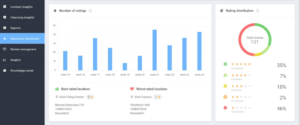
-
Respond quickly when someone leaves a bad review or a good one.
Responding to reviews is where the magic happens. It’s an opportunity to turn positive clients into brand advocates and to polish negative emotions away and replace them with positive sentiment. There are many best practices on how to best respond to certain review types but that’s outside the scope of this article. Do keep in mind the following core principles:
Be transparent
It’s common practice to be as transparent as possible when answering reviews. Hiding certain information can save you in the short term but is no solid foundation for long term brand reputation strategy. Therefore, be open about your business and try to respond to reviews with open arms.
Starbucks often got blamed for being not sustainable and eco-friendly. They listened to reviews and opened up a forum called My Starbucks Idea where they welcomed customers to suggest new products or eco-friendly innovations. As Starbucks environmental impact director Jim Hanna puts it:
“We’re going to continue to see more ‘gotcha’ moments,” Hanna said. “There’s no such thing as secrets anymore.”
Be quick
Always acknowledge and address criticism. Reviews are like endless stories on your page which will never disappear.
It looks bad when negative reviews are unanswered and stick on your page forever. Therefore, make it your daily habit to search for those 1-star reviews and see how you can ease the pain.
In many cases, using a quick reply as: “We are aware of the problem. We are working on it and will get back to you as soon as possible.” could potentially be better than a late reply with little more explanation.
It’s common practice to acknowledge the problem first and then offer them a solution to make them feel better again.
A little disclaimer here: be wary of people that deliberately place negative reviews in order to receive free stuff. In case you experience this, you should take legal steps against them.
Navads’ Ratings and Reviews tool offers a great way of gathering and sorting all your brand’s local reviews. A built-in handling tool helps you to directly answer them.
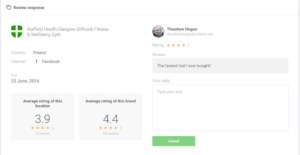
-
Learn from negative reviews and use reviews to improve your business.
Honest negative reviews are great learning points for your company. See them as feedback on your services, products, staff, or locations. Listening to your customer can prevent you from making the same mistake twice and in the future only will improve your business.
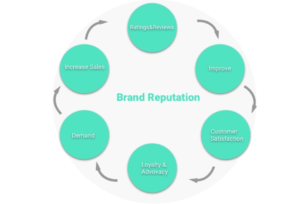
Concluding remarks
Controlling what people say about you is impossible; conversations will happen about you regardless of your efforts to steer it. Rather, brands should go back and assess how they can become a well-respected brand and find ways to actively manage their online brand reputation. Because as this article points out, in the zero-moment-of truth when people learn about your business it’s vital to have a transparent and truthful presence that inspires people to take action.
